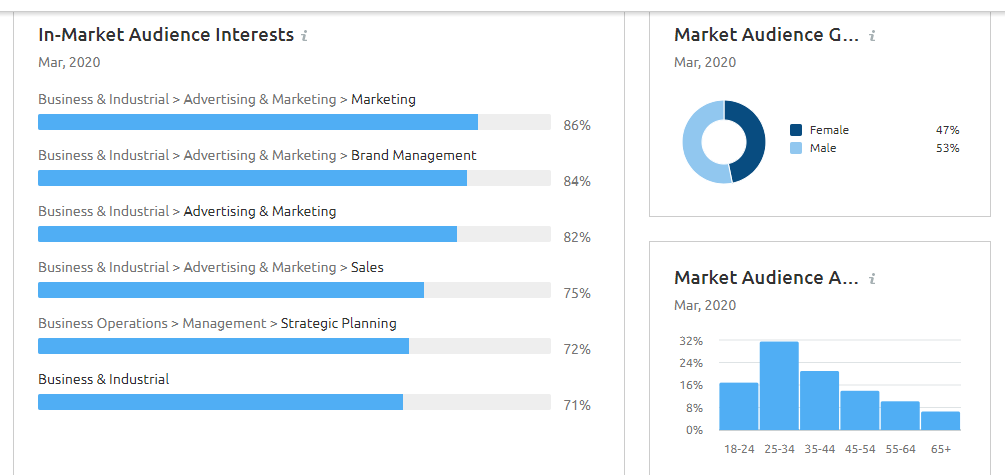There is no doubt in saying that the online industry is getting bigger day by day. And due to this, now there are many opportunities for marketers and business owners to boost their reach and scale their businesses to the maximum extent. The only problem is that with the advancement in time and technology, the varieties of audiences have also increased a lot, which has made it complicated for business owners to reach the right audience. This is the reason why it is very important to use a good quality online marketing tool to research your target market audience.
So if you are curious to learn more about the method to find more about your potential audience, then this article has a lot to offer. In this article, you will get to learn how to find who is your target audience using SEMrush. So if this sounds useful, then stick to this article.
Step 1 – Open The Market Explorer
One of the first things you have to do is open the market explorer. To open it, you have to select SEO tools, then a drop-down will appear where you can easily get to access the Market Explorer. It is a very useful tool that can provide you with all information regarding a niche and also help you understand the audience you are planning to target. With the help of this tool, you can use your competition to get information about the market and understand the audience better. It provides you with two ways to research your market, which are All Market and Narrow Focus.


As the name suggests, all market gives you a full picture of the entire market of your specific niche. It shows all the data that is relevant to your categories and domain. Coming to the narrow focus view narrows down the data and gives you information about your closest competitors. In short, it provides you with websites whose audiences have similar interests. To help you understand better, here are some applications of the Market Explorer Tool:
- You can get information about the platforms from where your competitor is getting the traffic.
- It helps in market size evaluation and bench-marking the top competitors.
- It enables you to analyze demographics such as gender, age, and interest.
Step 2 – Enter A Competitor’s Website
The next thing you have to do is enter the website of your competitor. We will use “neilpatel.com” in this example. Once you do this, the tool will give all the details of the market behaviour. There are multiple parameters like website categories, audience interests, common keywords, and many more that defines the market in this marketing tool.
Step 3 – Find Out The Key Information
Now it’s time to gather all the information regarding your potential target audience. The tool directly shows you the information but if you want to get deeper insights, then you should go to the domain vs market widget. This widget helps you analyze the audience of your competition.


With the help of this tool, you can easily filter out your competitor’s audience by age and gender. To get specific percentages, you will have to hover over the growth chart. Then you should move to the audience interest section to know about the things that the people are interested in. All this information is very useful and it will help you create powerful content campaigns to increase your audience and boost your reach.


Step 4 – Select 4 Competitors
Once you get all the details, you should start finding your top competitors. Though if you want to understand your competition better, then you must have a look at the growth quadrant. This helps you explore the market and the competition from various angles. There are 4 segments into which the market is divided and these are niche players, game-changer, leaders, and established players. The niche players are generally smaller sites that only focus on some small area of the market. They generally target a specific audience.
The game changers are also similar to niche players in terms of traffic but their growth rate is faster. The leaders comprise the top website that has a great growth rate along with decent traffic. At last, the established players are generally brands that have good traffic but whose growth rate is average.


You have to study the data properly and find some competitors’ websites. Just simply go to the relevant site’s section and it will give you a complete list of the websites of your competitors. We will use the below competitors for our analysis.
- searchenginehournal.com
- thinkwithgoogle.com
- moz.com
- sproutsocial.com
Step 5 – Go To Traffic Analytics To Analyze Your Competition
In this step, you have to take all the competitors’ websites and put them in the traffic analytics tool. This is the most important step and if you do everything properly, then here you will get all the essential information you want.


When you add the sites to the tool, it will show you a report giving all the information regarding user engagement, top traffic sources, and many more. In the user engagement section, you will get basic details about the audience.
For example, it will show the time audience is spending on the website, the bounce rate, and pages per session. It can give you an idea of how interactive the audience is in this niche. Apart from this, down below you will see the traffic sources report where you will find information about the platforms and channels that are bringing the larger percentage of traffic.


Step 6 – Find The Geographic Distribution Of Your Targeted Audience
Along with all the other metrics, the traffic analytics tool will also show you the geographic distribution of your targeted audience. Go to the traffic by countries section to know which countries are the most interested in your niche.


Though this will give you all the important information, still you should consider researching the traffic sources deeply. Start from the referral traffic and gradually move to search, social, and paid traffic.
Conclusion
Knowing who is your target audience is critical to the success of your business. If you know your target audience well, you can spend the marketing dollar effectively knowing that your message is reaching the right audience. The above process will give you some key insights about your potential audience and will take you closer to your marketing goals.


